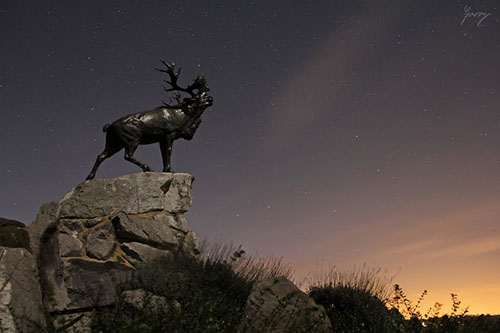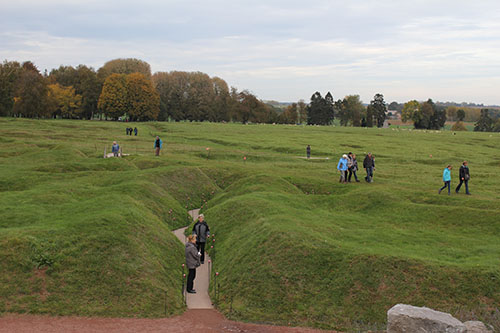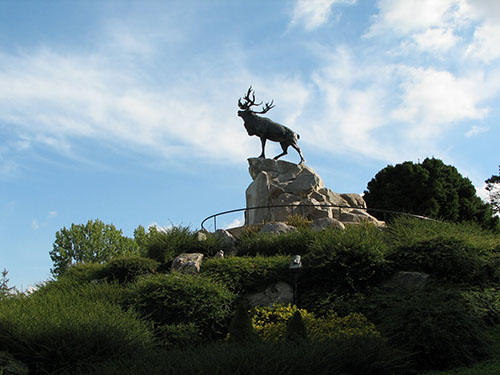



CLICK HERE TO HAVE YOUR RECYCLING PICKED UP AT YOUR DOOR!
Europe 2015: Adventure of a Lifetime! ![]() Europe 2015: Our 1,500km Journey Through History
Europe 2015: Our 1,500km Journey Through History ![]() Europe 2015: Sponsorship
Europe 2015: Sponsorship ![]() Europe 2015: Sponsor Hall of Fame
Europe 2015: Sponsor Hall of Fame
Scouts Recycle Initiative ![]() 2013 Canadian Jamboree
2013 Canadian Jamboree

Day Three: Newfoundland Memorial Park @ Beaumont-Hamel
 On July 1, 1916 the Royal Newfoundland Regiment bravely emerged from the trenches on the ill-fated allied "Battle of the Somme", which was the regiments first major battle of the war. Following British orders they stormed towards the German front and were cut down in terrible numbers by German crossfire. Alone on the battlefield with no allied support they were slaughtered, and after only 30 minutes nearly the entire regiment was dead or seriously wounded. In total, 710 Newfoundlanders were killed, wounded or missing out of the 870 that started out. Although their battle was not successful, their bravery and sacrifice inspired all nations.
On July 1, 1916 the Royal Newfoundland Regiment bravely emerged from the trenches on the ill-fated allied "Battle of the Somme", which was the regiments first major battle of the war. Following British orders they stormed towards the German front and were cut down in terrible numbers by German crossfire. Alone on the battlefield with no allied support they were slaughtered, and after only 30 minutes nearly the entire regiment was dead or seriously wounded. In total, 710 Newfoundlanders were killed, wounded or missing out of the 870 that started out. Although their battle was not successful, their bravery and sacrifice inspired all nations.
The memorial site is the largest battalion memorial on the Western Front, and the largest area of the Somme battlefield that has been preserved. Along with preserved trench lines, there are a number of memorials and cemeteries contained within the site. Our Scouts will be flying Newfoundland and Labrador flags as we pay respect to the brave soldiers who gave their lives trying to stop the terrible war. We bring soil from Newfoundland & Labrador so we can leave it behind at the graves of those that can never come home.
Overview of the Royal Newfoundland Regiments' Role in the Battle of the Somme
Excerpts from heritage.nf.ca => Promptly at 6:25 a.m. on July 1, the artillery bombardment began. At 7:20 a.m. the mines under Hawthorn Ridge exploded, warning the Germans that an attack was about to begin. The subsequent 10-minute delay in launching the offensive also allowed the Germans time to prepare for battle. Private John Ryan recalled thinking after the explosion, “That’s it, we’re licked” (Atwater 213).
Almost immediately, the opening phase of the 29th Division’s attack began to falter under withering enemy fire. Confusion was compounded by poor communication. General de Lisle mistook German flares for a signal of success from the attacking 87th Brigade, and ordered the 88th Brigade to move, with the Essex and Newfoundland Regiments advancing “as soon as possible.” But the Essex soldiers were unable to leave their trenches because of the large number of dead and wounded soldiers.
Thus it was that the Newfoundlanders moved off on their own at 9:15 a.m., their objective the first and second line of enemy trenches, some 650 to 900 metres away. In magnificent order, practiced many times before, they moved down the exposed slope towards No Man’s Land, the rear sections waiting until those forward reached the required 40-metre distance ahead. No friendly artillery fire covered the advance. A murderous cross-fire cut across the advancing columns and men began to drop, at first not many but then in large numbers as they approached the first gaps in their own wire. Private Anthony Stacey, who watched the carnage from a forward trench with Lieutenant-Colonel Hadow, stated that “[m]en were mown down in waves,"” and the gaps cut the night before were “a proper trap for our boys as the enemy just set the sights of the machine guns on the gaps in the barbed wire and fired” (Stacey 17A). Doggedly, the survivors continued on towards The Danger Tree. “The only visible sign that the men knew they were under this terrific fire,” wrote one observer, “was that they all instinctively tucked their chins into an advanced shoulder as they had so often done when fighting their way home against a blizzard in some little outport in far off Newfoundland” (Raley 37–40). Few advanced beyond it. Stacey recalled that from his vantage point he “could see no moving, but lots of heaps of khaki slumped on the ground” (Stacey 19). The few who did get to the German lines were horrified to discover that the week-long artillery barrage that preceded the attack had not cut the German barbed wire. This fact was known by commanders the night before, thanks to a report by a Newfoundland reconnaissance team. The news was dismissed on the grounds that it was due to the “nervousness of men who were facing battle for the first time” (Gilham). As a consequence, the majority of the soldiers who reached the enemy trenches were killed, tangled in the uncut wire.
 In less than 30 minutes it was all over. At 9:45 a.m., Hadow, who had witnessed the annihilation of his regiment from a forward position, reported to Brigade Headquarters that the attack had failed. Incredibly, he was ordered to collect up any unwounded and resume the attack. Fortunately, wiser counsel prevailed and the order was countermanded. Throughout the day survivors attempted the long and dangerous journey back to their own lines, many being an easy target for enemy snipers and artillery fire. Ron Dunn lay wounded on the battlefield for several days. On the second day, convinced that he would soon die, his thoughts turned homeward to Bonavista Bay and his mother. “I said me prayers,” he recalled, and then drifted off, unaware that rescue was on the way (Memorial).
In less than 30 minutes it was all over. At 9:45 a.m., Hadow, who had witnessed the annihilation of his regiment from a forward position, reported to Brigade Headquarters that the attack had failed. Incredibly, he was ordered to collect up any unwounded and resume the attack. Fortunately, wiser counsel prevailed and the order was countermanded. Throughout the day survivors attempted the long and dangerous journey back to their own lines, many being an easy target for enemy snipers and artillery fire. Ron Dunn lay wounded on the battlefield for several days. On the second day, convinced that he would soon die, his thoughts turned homeward to Bonavista Bay and his mother. “I said me prayers,” he recalled, and then drifted off, unaware that rescue was on the way (Memorial).
That night the search began for survivors. When the roll call was taken, only 68 responded. The full cost would not be known for several days. The final figures revealed that the regiment had been virtually wiped out: 710 killed, wounded or missing. Most were struck down before they reached beyond their own front line (Middlebrook 269).
The Battle of the Somme was the great turning point in the war. The hopes of a generation that went to war so willingly in 1914 were crushed once and for all. The “Big Push” did not bring the war to a swift conclusion. The battle lasted until November with inconclusive results and unleashed a bloodbath that continued unabated for another two years. The Somme laid waste to Kitchener’s Army, raised amidst the enthusiasm of the first year of the war. It also annihilated the Newfoundland Regiment, the colony’s premier contribution to the imperial war effort. The results were devastating, leaving Newfoundlanders bereft and confused, with a sense of loss that marked an entire generation. The legacy of the Battle of Beaumont Hamel continues to the present day, with special commemorations taking place every July 1.
Read the full story at heritage.nf.ca
 Thank You Jungle Jim's Grand Falls-Windsor!
Thank You Jungle Jim's Grand Falls-Windsor!
Our visit to the Newfoundland Memorial Park at Beaumont-Hamel has been sponsored thanks to a $2,000 donation from Jungle Jim's!
Click here to learn more about other ways you can help our youth!
Make a Donation to Support Our Scouts